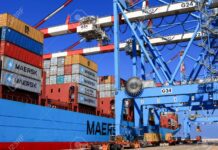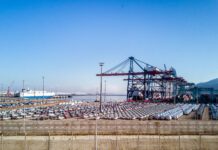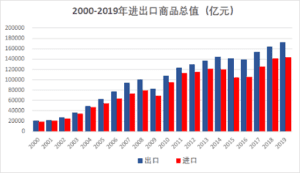The anti-globalization process characterized by trade frictions has turned into global geopolitical frictions during the COVID-19 pandemic. The degree of adjustment facing the global economy and politics may be deeper than most people expect. Although China is the second-largest economy in the world and the first to break free from the predicament caused by COVID-19, its economy has been particularly hit hard in the process of anti-globalization.
In his research on anti-globalization, Chan Kung, Chief Researcher at ANBOUND, once raised a question: Among the major powers involved in the global trade conflict, why do the countries with the most significant economic power have such different situations in coping with the pressure of anti-globalization? In his research, he compared the United States, China, and Germany. In 2018, the U.S. GDP ranked first in the world, reaching USD 20.49 trillion, accounting for 23.89% of the global economy. China’s economy is the second-largest in the world, with a GDP of USD 13.61 trillion, accounting for 15.86% of the global economy. Germany is the world’s fourth-largest economy, with a GDP of USD 3.99 trillion, accounting for 4.65% of the global economy. The combined economies of China and Germany are equivalent to 86% of the United States economy.
However, judging from the trade frictions between China and the United States, since last year, the challenges and pressures faced by China and Germany far exceed those faced by the United States. As a large emerging market, China has played the role of “the world’s factory” and become the biggest beneficiary of globalization since its accession to the WTO. China’s huge trade surplus with the United States has become an excuse for the United States to launch a trade war, and China has become the main target of “suppression” by the United States. As a core European country, Germany has world-renowned developed manufacturing industry and large enterprise group with global influence, and its global competitiveness has long been a leading position in the industry. But even such an old developed Western country with a far higher level of development than China is also facing strong pressure from the United States in the tide of anti-globalization. In our view, this difference in pressure is far greater than the difference in the economies of scale between the United States and China and Germany.
Why are China and Germany so passive in the trade frictions with the U.S.? Why are China, Germany, and the United States under such unequal pressure in the global market? It certainly cannot be explained well by the economic cycle, industrial cycle nor economic system differences.
According to ANBOUND’s researchers, the answer has to do with the fact that the world economy has entered a new stage of development — we have entered a “buyer’s world”. This so-called buyer’s world refers to the world in which countries with consumption power and market space have the final say. In a buyer’s world, what is valuable is not the great manufacturing power, nor cheap and plentiful goods, but the purchasing power of a country. Whether a country has the final say in the future world depends on its total consumption power, which is actually the market space of the country. Therefore, we propose that national competition in the new stage of globalization is actually a competition of market space that competes with the scale and capacity of market consumption.
Some would say that even as a buyer, China should not be so passive. Indeed, as China’s economy continues to grow, its urbanization level rises, and its residents’ incomes increase, China has begun to show its attractiveness as a huge consumer market. In 2019, China’s total retail sales of consumer goods reached RMB 41.2 trillion, and the contribution rate of consumption to the Chinese economy has been constantly increasing. In 2019, the contribution rate of final consumption expenditure to GDP growth was 57.8%, which was 26.6 percentage points higher than the total capital formation. With the continuous upgrading of 1.4 billion people’s consumption, no country can afford to ignore China’s influence and potential as a consumer market. For several years, ANBOUND has continuously emphasized the “Chinese market”, pointing out that in addition to the positioning as the “world factory”, there is market space that the buyer’s world values in China. At the same time, the market space is also an indication of the important direction that China’s future development should take.
The ensuing problem is that, China as the “world factory” takes the role as seller, but as the “Chinese market”, China is also the buyer of the world. It stands to reason that this positioning as both buyer and seller should give China more space. Why then, is China still subject to trade friction?
An important reason is that the formation of the buyer’s side is related to overproduction. Advances in science and technology, global industrial division of labor, the entry of large amounts of cheap labor from developing countries into the market, the advent of an information society, and the emergence and development of internet commerce all make overproduction occurs easily. To some extent, it is the development of globalization that creates a world of overproduction. In a world of overproduction, selling will not be as easy. This is an important reason why China and Germany are often challenged in trade wars.
Strictly speaking, from the perspective of China’s foreign trade structure, the country still cannot be regarded as a “net buyer” with huge market capacity. In the field of commodity trade, China has long been a net surplus country. In layman’s terms, China “sells” more than it “buys”. Statistics show that since 2014, China’s trade surplus has continuously exceeded RMB 2 trillion, ranging from RMB 2.3 trillion to RMB 3.7 trillion. Even at a simple glance this would show that China is a huge seller in the world.
Total Value of Chinese Imports and Exports 2000–2019 (hundred million RMB) )Fig 2 below
Some people may wonder: China also has a huge market, which imports a large number of commodities every year, such as oil (China imported 506 million tons of oil in 2019, or about USD 240 billion), iron ore (China imported 1.069 billion tons of iron ore in 2019), and semiconductor chips (China’s imports of chips in 2019 amounted to USD 304 billion), why doesn’t China have the final say? In fact, whether a country is a “seller” or a “buyer” depends on the overall economy, trade, and industry. From the perspective of China’s foreign trade, China as a whole is still a seller, not a buyer. Even if China has some buy-side goods with a little initiative in the local market, it is still a seller on the overall “balance sheet” scale. This is a “structural disadvantage” that China must face.
In a buyer’s world, the market space has become important competitiveness of a country. Although China is the “world’s factory” and is also developing the “Chinese market”, on the whole, China is still a main seller in the world. In the process of anti-globalization, China will still face many arduous challenges as a seller.
Mr. He Jun takes the roles as Partner, Director of China Macro-Economic Research Team and Senior Researcher. His research field covers China’s macro-economy, energy industry and public policy











































